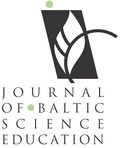DEVELOPMENT OF AN INQUIRY ACTIVITY MODEL EMPHASIZING THE REPRESENTATION OF PRIMARY SCIENCE TEXTBOOKS
| Title | DEVELOPMENT OF AN INQUIRY ACTIVITY MODEL EMPHASIZING THE REPRESENTATION OF PRIMARY SCIENCE TEXTBOOKS |
| Publication Type | Journal Article |
| Year of Publication | 2024 |
| Authors | Kim, S, Kim, JB |
| Journal | Journal of Baltic Science Education |
| Volume | 23 |
| Issue | 2 |
| Start Page | 315-330 |
| Pagination | Continuous |
| Date Published | April/2024 |
| Type of Article | Original article |
| ISSN | 1648-3898 |
| Other Numbers | E-2538-7138 |
| Keywords | inquiry activity model, inquiry phase, primary science textbook, representation in inquiry activity |
| Abstract | Despite increased research interest in improving students' scientific inquiry abilities, how to conduct scientific inquiry using science textbooks that are easily accessible to primary school students remains understudied. This study developed and verified an inquiry activity model (IAM) to improve the performance of primary school students in science textbook inquiry activities. Data were collected from sixth-grade primary students (n = 167) to analyze the difficulty level of textbook inquiry activities. An analysis tool was developed, focusing on inquiry skills and process flow. Expert analysis increased the tool’s validity. The analysis revealed that students possessed low integrated inquiry skills, were partially aware of the inquiry process flow, and could not design experiments. Hence, the IAM was developed to enhance students’ ability to perform textbook inquiry activities and understand the activity phases. It emphasized the flow and representation of the inquiry process for students to easily recall the contents as they learn the interconnectivity between phases. The post-test of the experimental group and the inquiry process flow chart showed significant improvement in all areas of inquiry ability. The scores for “connections” and “interconnectivity” in the inquiry process flow were high, reflecting the model’s effectiveness in showing the interconnectedness of all stages. |
| URL | https://oaji.net/articles/2023/987-1713273156.pdf |
| DOI | 10.33225/jbse/24.23.315 |
| Refereed Designation | Refereed |
| Full Text |
